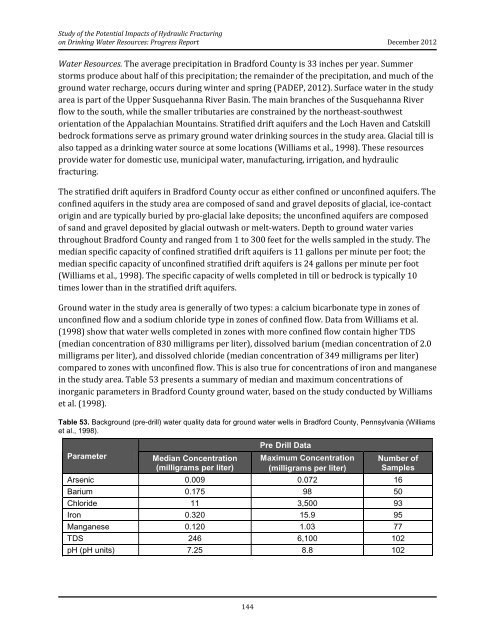hf-report20121214
hf-report20121214
hf-report20121214
Create successful ePaper yourself
Turn your PDF publications into a flip-book with our unique Google optimized e-Paper software.
Study of the Potential Impacts of Hydraulic Fracturing<br />
on Drinking Water Resources: Progress Report December 2012<br />
Water Resources. The average precipitation in Bradford County is 33 inches per year. Summer<br />
storms produce about half of this precipitation; the remainder of the precipitation, and much of the<br />
ground water recharge, occurs during winter and spring (PADEP, 2012). Surface water in the study<br />
area is part of the Upper Susquehanna River Basin. The main branches of the Susquehanna River<br />
flow to the south, while the smaller tributaries are constrained by the northeast-southwest<br />
orientation of the Appalachian Mountains. Stratified drift aquifers and the Loch Haven and Catskill<br />
bedrock formations serve as primary ground water drinking sources in the study area. Glacial till is<br />
also tapped as a drinking water source at some locations (Williams et al., 1998). These resources<br />
provide water for domestic use, municipal water, manufacturing, irrigation, and hydraulic<br />
fracturing.<br />
The stratified drift aquifers in Bradford County occur as either confined or unconfined aquifers. The<br />
confined aquifers in the study area are composed of sand and gravel deposits of glacial, ice-contact<br />
origin and are typically buried by pro-glacial lake deposits; the unconfined aquifers are composed<br />
of sand and gravel deposited by glacial outwash or melt-waters. Depth to ground water varies<br />
throughout Bradford County and ranged from 1 to 300 feet for the wells sampled in the study. The<br />
median specific capacity of confined stratified drift aquifers is 11 gallons per minute per foot; the<br />
median specific capacity of unconfined stratified drift aquifers is 24 gallons per minute per foot<br />
(Williams et al., 1998). The specific capacity of wells completed in till or bedrock is typically 10<br />
times lower than in the stratified drift aquifers.<br />
Ground water in the study area is generally of two types: a calcium bicarbonate type in zones of<br />
unconfined flow and a sodium chloride type in zones of confined flow. Data from Williams et al.<br />
(1998) show that water wells completed in zones with more confined flow contain higher TDS<br />
(median concentration of 830 milligrams per liter), dissolved barium (median concentration of 2.0<br />
milligrams per liter), and dissolved chloride (median concentration of 349 milligrams per liter)<br />
compared to zones with unconfined flow. This is also true for concentrations of iron and manganese<br />
in the study area. Table 53 presents a summary of median and maximum concentrations of<br />
inorganic parameters in Bradford County ground water, based on the study conducted by Williams<br />
et al. (1998).<br />
Table 53. Background (pre-drill) water quality data for ground water wells in Bradford County, Pennsylvania (Williams<br />
et al., 1998).<br />
Parameter<br />
Median Concentration<br />
(milligrams per liter)<br />
Pre - Drill Data<br />
Maximum Concentration<br />
(milligrams per liter)<br />
Number of<br />
Samples<br />
Arsenic 0.009 0.072 16<br />
Barium 0.175 98 50<br />
Chloride 11 3,500 93<br />
Iron 0.320 15.9 95<br />
Manganese 0.120 1.03 77<br />
TDS 246 6,100 102<br />
pH (pH units) 7.25 8.8 102<br />
144


